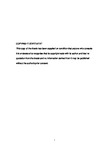Distributions of glycine betaine and the methylamines in coastal waters: analytical developments and a seasonal study
| dc.contributor.supervisor | Mark, Fitzsimons | |
| dc.contributor.author | Cree, Charlotte | |
| dc.contributor.other | Faculty of Science and Engineering | en_US |
| dc.date.accessioned | 2015-07-17T12:32:54Z | |
| dc.date.available | 2015-07-17T12:32:54Z | |
| dc.date.issued | 2015 | |
| dc.date.issued | 2015 | |
| dc.identifier | 285120 | en_US |
| dc.identifier.uri | http://hdl.handle.net/10026.1/3441 | |
| dc.description | Carried out in collaboration with Plymouth Marine Laboratory | en_US |
| dc.description.abstract |
A novel technique comprising solid phase microextraction and gas chromatography has been developed to analyse the three methylamines (monomethylamine, dimethylamine and trimethylamine) at the concentrations expected in seawater. The volatility of the methylamines was exploited and allowed the headspace pre-concentration and gas chromatographic separation of the analytes. This method achieved limits of detection of 0.43 nmol dm-3, 2.50 nmol dm-3 and 0.37 nmol dm-3 for monomethylamine, dimethylamine and trimethylamine, respectively, which are lower than any previously reported for seawater. This technique was applied to natural samples collected from the Western English Channel (WEC) and the methylamines were successfully quantified. A liquid chromatography-mass spectrometry method was used to analyse glycine betaine in marine particulates. The volume filtered during sample collection was found to be critical in achieving accurate measurements of glycine betaine. Large filter volumes (1 L) significantly decreased observed concentrations compared to smaller volumes, and 10 mL was the optimised amount filtered. The difference in concentrations was attributed to large water volumes causing cell damage and loss of glycine betaine to the dissolved phase. Cell resilience was thought to play a role in the differences observed; for example, diatoms with their rigid silica cell walls were hypothesised to be more resilient to filtration stress. A seasonal study was carried out in the WEC using both 1 L and 10 mL samples and maximum glycine betaine concentrations were 50 nmol dm-3 and 484 nmol dm-3 in the 1 L and 10 mL samples, respectively. The latter concentrations were more than an order of magnitude higher than all previous measurements. Seasonality was observed and a significant correlation was found with chlorophyll a. Statistics were applied to the phytoplankton biomass data and contributions from specific phytoplankton taxa were identified, including from Prorocentrum minimum and Chaetoceros socialis. | en_US |
| dc.description.sponsorship | Natural Environment Research Council | en_US |
| dc.language.iso | en | en_US |
| dc.publisher | Plymouth University | en_US |
| dc.subject | Glycine betaine | |
| dc.subject | Coastal water | |
| dc.subject | Analytical development | |
| dc.subject | Seasonal study | |
| dc.subject | Methylamines | en_US |
| dc.title | Distributions of glycine betaine and the methylamines in coastal waters: analytical developments and a seasonal study | en_US |
| dc.type | Thesis | |
| plymouth.version | Full version | en_US |
| dc.identifier.doi | http://dx.doi.org/10.24382/4392 |
Files in this item
This item appears in the following Collection(s)
-
01 Research Theses Main Collection
Research Theses Main


